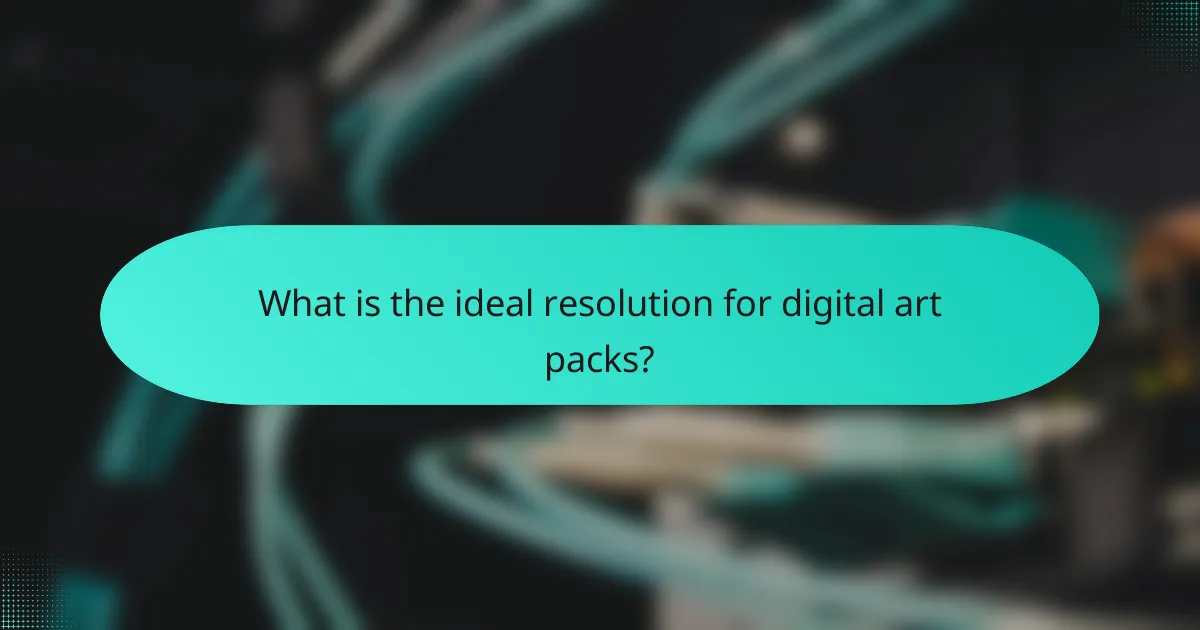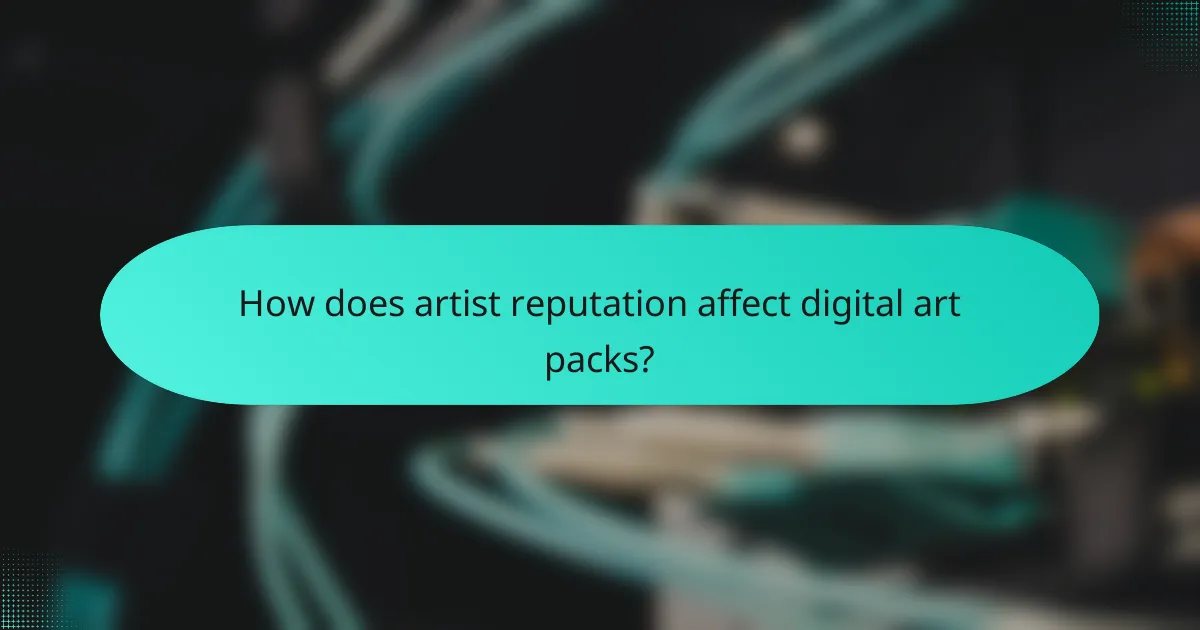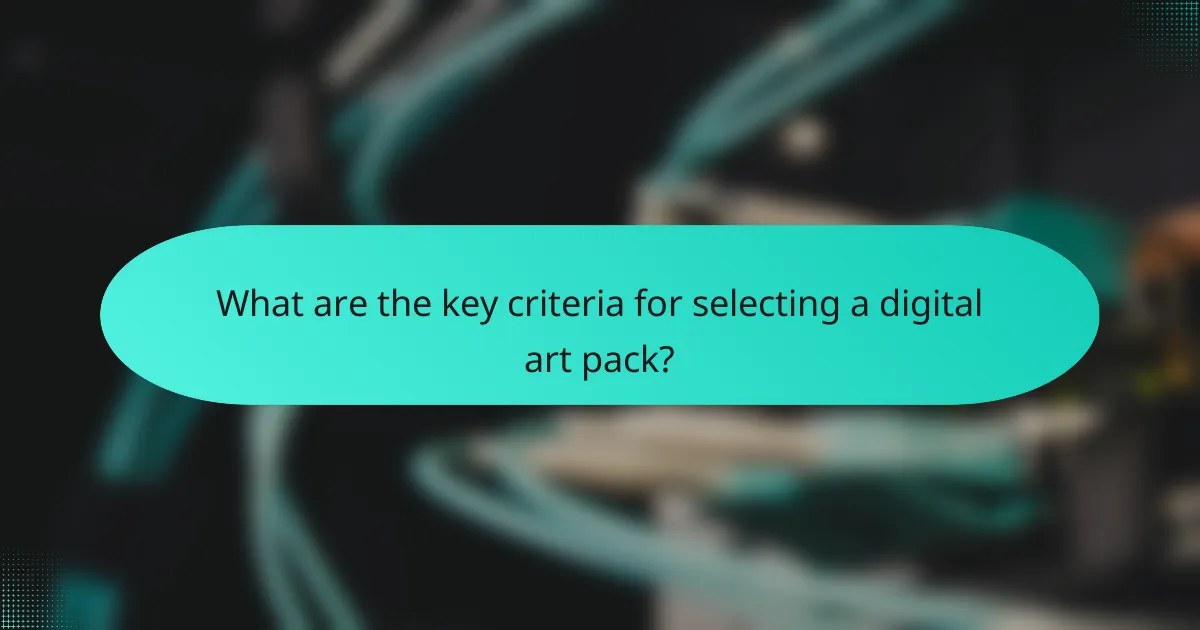Digital art packs are versatile collections that include various file formats such as JPEG, PNG, PSD, TIFF, and SVG, each tailored for specific uses like image quality and editing. The resolution of these packs is crucial, with 300 DPI recommended for print and 72 DPI for web, ensuring optimal display across different platforms. Additionally, the reputation of the artist plays a significant role in the value of these packs, as established creators often command higher prices due to their credibility and experience in the field.

What digital art pack file formats are available?
Digital art packs typically include several file formats, each serving different purposes. Common formats include JPEG, PNG, PSD, TIFF, and SVG, which cater to various needs such as image quality, transparency, and editing capabilities.
JPEG for images
JPEG is a widely used format for digital images, known for its efficient compression that reduces file size while maintaining reasonable quality. This makes it ideal for web use and sharing, where loading speed is essential.
However, JPEG does not support transparency and can lose detail with excessive compression. For best results, aim for a balance between quality and file size, typically keeping the quality setting around 70-80% for online use.
PNG for transparency
PNG is the go-to format for images that require transparency, making it perfect for logos and graphics overlaid on different backgrounds. Unlike JPEG, PNG files maintain high quality without losing detail, even with transparent areas.
While PNG files are larger than JPEGs, they are essential when you need clear, crisp edges and the ability to layer images. Use PNG for graphics that demand high fidelity and transparency, especially in digital art projects.
PSD for Adobe Photoshop
PSD is the native file format for Adobe Photoshop, allowing artists to save layers, masks, and other editing features. This format is crucial for ongoing projects where adjustments and edits are frequently needed.
Keep in mind that PSD files can become quite large, especially with multiple layers. For collaboration, consider exporting to other formats once the artwork is finalized, while retaining the PSD for future edits.
TIFF for high quality
TIFF is favored for its high-quality image storage, making it suitable for print and professional use. This format supports various color depths and is lossless, preserving all image details without compression artifacts.
While TIFF files can be significantly larger than JPEG or PNG, they are ideal for archiving and printing. Use TIFF when quality is paramount, such as for gallery prints or detailed artwork reproduction.
SVG for vector graphics
SVG is a vector format that allows for scalable graphics without loss of quality, making it perfect for logos, icons, and illustrations. Since SVG files are based on mathematical expressions, they remain crisp at any size.
This format is particularly useful for web applications, as SVG files can be manipulated with CSS and JavaScript. Use SVG for graphics that need to maintain clarity across different resolutions and devices.

What is the ideal resolution for digital art packs?
The ideal resolution for digital art packs depends on their intended use, primarily focusing on print quality or web display. Generally, resolutions of 300 DPI for print and 72 DPI for web are standard, with higher resolutions like 4K providing exceptional detail for various applications.
300 DPI for print quality
For printed materials, a resolution of 300 DPI (dots per inch) is recommended to ensure sharp and clear images. This standard is crucial for artworks that will be reproduced in physical formats, such as posters or books, where detail and color accuracy are paramount.
When preparing digital art for print, consider the size of the final output. For example, if you plan to print an 8×10 inch piece, the digital file should be at least 2400×3000 pixels to meet the 300 DPI requirement. Always check with your printing service for any specific guidelines they may have.
72 DPI for web use
For digital art intended for online platforms, a resolution of 72 DPI is typically sufficient. This lower resolution helps to reduce file sizes, ensuring faster loading times on websites and social media without sacrificing visual quality on screens.
Keep in mind that while 72 DPI is standard, the actual pixel dimensions should still be large enough to display well on various devices. For instance, a common size for web images is 1920×1080 pixels, which provides a good balance between quality and performance.
4K resolution for high detail
4K resolution, which is approximately 3840×2160 pixels, is ideal for high-detail digital art, especially for displays that support ultra-high-definition. This resolution is increasingly popular for digital galleries, video content, and high-end prints, allowing for intricate details to be showcased effectively.
When creating art at 4K resolution, consider the capabilities of your target audience’s devices. While 4K provides stunning clarity, it also results in larger file sizes, which may not be suitable for all platforms. Optimize your files for the intended use to maintain a balance between quality and accessibility.

How does artist reputation affect digital art packs?
Artist reputation significantly influences the pricing and desirability of digital art packs. Established artists often charge more due to their proven track record, while lesser-known creators may struggle to gain traction in a competitive market.
Established artists command higher prices
Artists with a strong reputation can typically charge premium prices for their digital art packs. For instance, well-known illustrators or graphic designers may price their packs in the range of $50 to $200, depending on the complexity and uniqueness of the content. In contrast, emerging artists might sell similar packs for $10 to $30, reflecting their lesser-known status.
Buyers are often willing to invest more in art packs from recognized names, believing that the quality and creativity will be superior. This trend underscores the importance of building a personal brand in the digital art space.
Reputation influences perceived value
The perceived value of digital art packs is closely tied to the artist’s reputation. A pack from a celebrated artist may be viewed as more valuable, leading to higher sales even if the content is similar to that of lesser-known creators. This perception can be influenced by factors such as past awards, collaborations, and social media presence.
For example, a digital art pack from an artist featured in major publications or with a significant online following is likely to attract more buyers than one from an unknown artist, regardless of the actual quality of the work.
Reviews and ratings impact sales
Customer reviews and ratings play a crucial role in the sales of digital art packs. Positive feedback can enhance an artist’s reputation and encourage new buyers to make a purchase. A pack with numerous high ratings can often sell better than a similar pack with few or negative reviews.
To maximize sales, artists should actively seek feedback from buyers and respond to reviews. Engaging with customers can help build a loyal following and improve overall reputation, leading to increased sales over time.

What are the key criteria for selecting a digital art pack?
When selecting a digital art pack, consider file format compatibility, resolution requirements, and artist credibility. These factors ensure that the artwork meets your technical needs and comes from a reliable source.
File format compatibility
File format compatibility is crucial for ensuring that the digital art can be easily used in your projects. Common formats include JPEG, PNG, TIFF, and PSD, each serving different purposes. For instance, PNG is preferred for images requiring transparency, while TIFF is often used for high-quality prints.
Before purchasing, check the software you plan to use and confirm that the file formats are supported. This can save time and prevent frustration when integrating the art into your workflow.
Resolution requirements
Resolution is key to the quality of digital art, especially for print projects. A resolution of at least 300 DPI (dots per inch) is recommended for print, while 72 DPI is generally sufficient for web use. Higher resolutions provide more detail but also result in larger file sizes.
When selecting a digital art pack, consider the intended use. For example, if you need artwork for a large banner, opt for higher resolution files to maintain clarity when scaled. Always verify the resolution specifications before making a purchase.
Artist credibility
Artist credibility plays a significant role in the value of a digital art pack. Look for artists with a strong portfolio, positive reviews, and a history of successful projects. Established artists often have a recognizable style and a track record of delivering quality work.
Researching an artist’s background can help you gauge their expertise and reliability. Platforms like Behance or ArtStation can provide insights into their previous work and client feedback, ensuring you invest in quality art that meets your expectations.

What are the pricing models for digital art packs?
The pricing models for digital art packs typically include one-time purchases, subscription-based access, and tiered pricing based on resolution. Each model offers different advantages depending on the user’s needs and budget.
One-time purchase pricing
One-time purchase pricing allows users to buy a digital art pack outright, providing permanent access to the files. This model is straightforward and appealing for those who prefer to own their assets without ongoing costs.
Prices for one-time purchases can vary widely, often ranging from $10 to several hundred dollars, depending on the complexity and quality of the artwork. Users should consider their usage needs and whether they might require future updates or additional content.
Subscription-based access
Subscription-based access offers users the ability to pay a recurring fee, typically monthly or annually, for access to a library of digital art packs. This model is beneficial for artists and designers who frequently need new content without the upfront cost of multiple purchases.
Subscriptions can range from around $5 to $50 per month, depending on the platform and the number of assets included. Users should evaluate how often they will use the service to determine if a subscription is cost-effective compared to one-time purchases.
Tiered pricing for different resolutions
Tiered pricing for different resolutions allows users to choose from various price points based on the resolution of the digital art files. Higher resolutions typically come at a premium, catering to professional users who require high-quality images for print or detailed work.
For example, a digital art pack might be priced at $20 for standard resolution and $50 for high resolution. Users should assess their specific needs, such as whether they will use the art for web or print, to select the appropriate tier without overspending.
